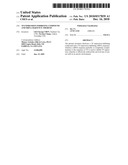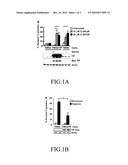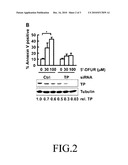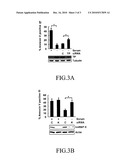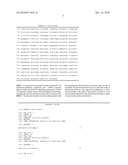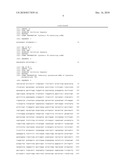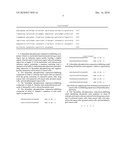Patent application title: TP EXPRESSION-INHIBITING COMPOUND AND SIRNA SEQUENCE THEREOF
Inventors:
Lih-Chyang Chen (Xindian City, TW)
Yu-Sun Chang (Linkou Township, TW)
IPC8 Class: AC07H2102FI
USPC Class:
536 231
Class name: Nitrogen containing n-glycosides, polymers thereof, metal derivatives (e.g., nucleic acids, oligonucleotides, etc.) dna or rna fragments or modified forms thereof (e.g., genes, etc.)
Publication date: 2010-12-16
Patent application number: 20100317839
Claims:
1. A thymidine phosphorylase expression-inhibiting compound, which is a
nucleotide-based molecule having a sense region and an antisense region
jointly forming a duplex region, wherein each of said sense region and
said antisense region has a length of 18-30 nucleotides, and wherein said
antisense region containing a sequence matching with a sequence of an
mRNA of thymidine phosphorylase and inhibiting expression of thymidine
phosphorylase and suppress growth, metastasis and invasion of cancer
cells.
2. The thymidine phosphorylase expression-inhibiting compound of claim 1, wherein said cancer cells are selected from the group consisting of colorectal cancer cells, lung cancer cells, oral squamous cell cancer cells, prostate cancer cells, and nasopharyngeal cancer cells.
3. The thymidine phosphorylase expression-inhibiting compound of claim 1, wherein said nucleotide-based molecule is ribonucleic acid or deoxyribonucleic acid.
4. The thymidine phosphorylase expression-inhibiting compound of claim 1, wherein a sequence of said sense region is expressed by TABLE-US-00004 GGACAAGCAUUCCACAGGGUU (SEQ ID NO: 1) CAGCCUCCAUUCUCAGUAAUU (SEQ ID NO: 2) GCAUGUGGCUGCAAGGUGCUU (SEQ ID NO: 3) GAGCGAAGCGGACAUCAGGUU (SEQ ID NO: 4)
5. A thymidine phosphorylase expression-inhibiting small interfering ribonucleic acid sequence, which is expressed by TABLE-US-00005 GGACAAGCAUUCCACAGGGUU (SEO ID NO: 1) CAGCCUCCAUUCUCAGUAAUU (SEQ ID NO: 2) GCAUGUGGCUGCAAGGUGCUU (SEQ ID NO: 3) GAGCGAAGCGGACAUCAGGUU (SEQ ID NO: 4)
and which can suppress growth, metastasis and invasion of cancer cells via inhibiting expression of thymidine phosphorylase.
6. The thymidine phosphorylase expression-inhibiting small interfering ribonucleic acid sequence of claim 5, wherein said cancer cells are selected from the group consisting of colorectal cancer cells, lung cancer cells, oral squamous cell cancer cells, prostate cancer cells, and nasopharyngeal cancer cells.
Description:
FIELD OF THE INVENTION
[0001]The present invention relates to an RNA interferon technology, particularly to a TP expression-inhibiting compound and a siRNA sequence thereof.
DESCRIPTION OF THE RELATED ART
[0002]Thymidine phosphorylase (TP), also called PD-ECGF (Platelet-Derived Endothelial Cell Growth Factor), plays a very important role in nucleotide metabolism. TP also induces angiogenesis and metastasis. Thus, TP can inhibit apoptosis. It was reported that the product of TP metabolism 2-deoxy-D-ribose can inhibit the anoxia-induced apoptosis. It has been known that TP is over expressed in many cancers and very useful in prognosis. The over-expression of TP and the activity of enzyme can catalyze the activity of a precursor medicine of capecitabine. TP has been allowed to use in the therapy of the patients of metastatic colorectal cancer and metastatic breast cancer. The TP promoter is regulated by the transcription factors Spl and STAT. Besides, the stability of TP RNA is regulated by an interferon on the post-transcription level.
[0003]The Inventors found that TP is over-expressed in nasopharyngeal cancer and clinically correlates with the overall survival rate and distant metastasis. Therefore, PT can be used as a biomarker for predicting the malignancy of cancer. In the current cancer therapy technology, there is still none molecular method or medicine inhibiting the expression of TP-the over-expressing gene in breast cancer, colorectal cancer, and nasopharyngeal cancer.
SUMMARY OF THE INVENTION
[0004]The primary objective of the present invention is to provide a TP (Thymidine Phosphorylase) expression-inhibiting compound and a siRNA (small interfering RNA) sequence thereof, wherein the siRNA corresponding to TP is used to effectively inhibit TP expression and suppress the growth, metastasis and invasion of cancer.
[0005]To achieve the abovementioned objective, the present invention proposes a TP expression-inhibiting compound and a siRNA sequence thereof, wherein a siRNA is used to inhibit TP expression, and wherein a small segment of RNA having about 18-24 pieces of nucleotides matches with the mRNA (messenger RNA) of TP and then the intracellular dicer recognizes the segment of RNA, whereby the mRNA of TP is cut off, and the TP expression is inhibited.
[0006]The siRNA designed by the present invention matches with TP mRNA and has a transcribable sequence
TABLE-US-00001 GGACAAGCAUUCCACAGGGUU CAGCCUCCAUUCUCAGUAAUU GCAUGUGGCUGCAAGGUGCUU GAGCGAAGCGGACAUCAGGUU
which can inhibit TP expression and thus can reduce the survival rate of cancer cells in an anoxic environment.
[0007]Below, the present invention is described in detail in cooperation with the attached drawings to make easily understood the objective, characteristics and accomplishments of the present invention.
BRIEF DESCRIPTION OF THE DRAWINGS
[0008]FIGS. 1A and 1B are diagrams respectively schematically showing the influence of TP expression on the cell line of nasopharyngeal cancer in a 5'-DFUR environment and an anoxic environment;
[0009]FIG. 2 is a diagram schematically showing the effect of a TP expression-inhibiting compound according to the present invention; and
[0010]FIGS. 3A and 3B are diagrams schematically showing the effect of a TP expression-inhibiting compound according to the present invention.
DETAILED DESCRIPTION OF THE INVENTION
[0011]The TP (Thymidine Phosphorylase) expression-inhibiting compound and a siRNA (small interfering RNA) sequence thereof can effectively inhibit TP expression and thus can reduce the survival rate of cancer cells in an anoxic environment and can then suppress the growth of cancer cells, includes colorectal cancer, lung cancer, oral squamous cell cancer, prostate cancer, nasopharyngeal cancer. The nasopharyngeal cancer cells are used as the exemplification of the abovementioned cancer cells in the present invention.
[0012]In related experiments, the Inventors found that Protein K of ribonucleoprotein particles (hnRNP K) and the target thereof--TP are over-expressed in nasopharyngeal cancer. The abnormal hnRNP K expression and TP over-expression in cytoplasm correlates with the shorter overall survival period and the distant metastasis. A multivariate analysis shows that hnRNP K and TP in cytoplasm is the independent factor for prognosis. TP over-expression in nasopharyngeal cancer cells makes the cancer cells more sensitive to the intermediate product of capecitabine--the precursor medicine 5-fluoro-5'-deoxyuridine (5'-DFUR), which can induce the apoptosis of cancer cells. Besides, the removal of serum will increase the stability of TP and cause TP over-expression.
[0013]RT-PCR-based immunoprecipitation and the transfer of hnRNP K from nucleus to cytoplasm shows that a UMP and CMP-rich segment of TP can directly interact with hnRNP K. Therefore, inhibiting hnRNP K expression can reduce TP expression. It means that hnRNP K should be the upstream of TP. In the reaction mechanism, both the MEK inhibitor (Mitogen-activated protein/Extracellular signal-regulated Kinase) and the amino mutation of p-ERK (phosphorylated Extracellular signal-Regulated kinases) can reduce hnRNP K expression in cytoplasm. Therefore, the phosphorylation of hnRNP K by ERK maybe plays an important role in inducing TP.
[0014]Besides, the TP expression activated by hnRNP K can inhibit the anoxic apoptosis of nasopharyngeal cancer cells. In conclusion, our experiments show that ERK can induce increasing hnRNP K expression. Thus, hnRNP K is the upstream of TP, and TP is the downstream target of hnRNP K. Both hnRNP K and TP are effective indicators to prognose nasopharyngeal cancer and deserves designing new targeted-therapy medicine thereof, which should benefit cancer therapy.
[0015]Therefore, the present invention suppresses the growth, metastasis and invasion of nasopharyngeal cancer via inhibiting TP expression. The TP expression-inhibiting compound may be the nucleotide molecules of RNA or DNA, which has a sense region and an antisense region jointly forming a duplex region. The sense region and the antisense region respectively have a length of 18-30 nucleotides. The antisense region has a sequence completely or partially matching the sequence of the mRNA of TP, whereby TP expression is inhibited, and the growth, metastasis, and invasion of cancer cells is suppressed.
[0016]In other words, the TP-inhibiting siRNA contains the following sequence:
TABLE-US-00002 GGACAACCAUUCCACAGGGUU CAGCCUCCAUUCUCAGUAAUU GCAUGUGGCUGCAAGGUGCUU GAGCGAAGCGGACAUCAGGUU
[0017]Below, experimental data is used to prove the efficacies of the present invention. The cell lines of nasopharyngeal cancer NPC-TW01, NPC-TW02 and NPC-TW04 were cultivated in DMEM (Dulbecco's Modified Eagle's Medium) supplemented with 10% fetal bovine serum, 100 U/ml penicillin, and 100 μg/ml streptomycin at a temperature of 37° C. in a humidified 5% CO2 atmosphere. The cells are also cultivated in a serum-free DMEM, i.e. treated with a serum deprivation process. The cell lines NPC-TW02 is cultivated in DMEM supplemented with 10% fetal bovine serum, 100 U/ml penicillin, and 100 μg/ml streptomycin at 37° C. in a humidified 5% CO2 atmosphere. The expression of endogenous TP can be induced by the serum deprivation processing, as shown in FIG. 1A.
[0018]Refer to FIG. 1A and FIG. 1B. A cell line of nasopharyngeal cancer NPC-TW02/TP is established to stably express exogenous TP. First, the TP-expression carrier pcDNA3.1-PT is transfected to the cell line. Next, the cell line is screened and then cultivated in a culture solution having 500 μg/ml G418. Next is performed a cytotoxicity assay, wherein NPC-TW02 and NPC-TW02/TP are respectively processed with 5'-DFUR (Sigma-Aldrich, St. Louis, Mo., USA). Next, the cell lines are further cultivated for 72 hours. Next, the cell membranes are everted to expose phosphatidylserine. Then, phosphatidylserine is analyzed with the Vybrant® Apoptosis Assay Kit #2 (a product of Invitrogen).
[0019]Firstly, 2×105 cells are taken out and washed with PBS. Next, a buffer solution (10 mM HEPES, 140 mM NaCl, 2.5 mM CaCl2, pH 7.4) is used to adjust the solution to have a cell concentration of 2×106/mL. Next, 5 μl Alexa Fluor® 488 annexin V is added into 100 μl cell suspension, and then the cell suspension reacts at an ambient temperature for 15 minutes. Next, the cell specimens (10000 events) are analyzed with a flow cytometer (a product of Becton Dickinson), as shown in FIG. 3. Next is performed an anoxic experiment, wherein a six-hole culture tray planted with cells is placed in a modular incubator chamber (Billups-Rothenberg, Del Mar, Calif.), and an air having 2% O2, 5% CO2, and 93% N2 flows through the incubator chamber with a flow rate of 20 l/min for 8 minutes. Next, the incubator chamber is sealed, and the cells are cultivated for 72 hours at a temperature of 37° C. Refer to FIG. 2. Next, the cell membranes are everted to expose phosphatidylserine. Then, phosphatidylserine is analyzed with the Vybrant® Apoptosis Assay Kit #2 (a product of Invitrogen).
[0020]According to the operation manual, 50 μg transfection agent TransIT-TKO (a product of Mirus Bio Corporation) is used to transfect 50 nmol/l dsRNA duplexes to the cell line NPC-TW02, wherein a 21-bp hnRNP K and TP-addressing RNA duplex (SMARTpool reagents, Dharmacon, Lafayette, Colo.) and a 21-bp none-addressing RNA duplex (Research Biolabs Ayer Rajah Industrial Estate) are transfected to the cell line NPC-TW02. 24 hours later from transfection, the siRNA-containing culture solution is replaced with a serum-containing culture solution and a serum-free culture solution. Refer to FIG. 2, FIG. 3A and FIG. 3B. 48 hours later from culture solution replacement, the cells are collected to extract cell protein to examine the gene expression-inhibiting effect of the transfected RNA duplexes.
[0021]The mRNA of TP may have a sequence shown in Table. 1.
TABLE-US-00003 TABLE 1 1 cgactgccga gctccgccct ccaggcggcc ccacccgcct gccgtcctgg ggcgccgccg 61 ccccgccgcc ggcagtggac cgctgtgcgc gaaccctgaa ccctacggtc ccgacccgcg 121 ggcgaggccg ggtacctggg ctgggatccg gagcaagcgg gcgagggcag cgccctaagc 181 aggcccggag cgatggcagc cttgatgacc ccgggaaccg gggccccacc cgcgcctggt 241 gacttctccg gggaagggag ccagggactt cccgaccctt cgccagagcc caagcagctc 301 ccggagctga tccgcatgaa gcgagacgga ggccgcctga gcgaagcgga catcaggggc 361 ttcgtggccg ctgtggtgaa tgggagcgcg cagggcgcac agatcggggc catgctgatg 421 gccatccgac ttcggggcat ggatctggag gagacctcgg tgctgaccca ggccctggct 481 cagtcgggac agcagctgga gtggccagag gcctggcgcc agcagcttgt ggacaagcat 541 tccacagggg gtgtgggtga caaggtcagc ctggtcctcg cacctgccct ggcggcatgt 601 ggctgcaagg tgccaatgat cagcggacgt ggtctggggc acacaggagg caccttggat 661 aagctggagt ctattcctgg attcaatgtc atccagagcc cagagcagat gcaagtgctg 721 ctggaccagg cgggctgctg tatcgtgggt cagagtgagc agctggttcc tgcggacgga 781 atcctatatg cagccagaga tgtgacagcc accgtggaca gcctgccact catcacagcc 841 tccattctca gtaagaaact cgtggagggg ctgtccgctc tggtggtgga cgttaagttc 901 ggaggggccg ccgtcttccc caaccaggag caggcccggg agctggcaaa gacgctggtt 961 ggcgtgggag ccagcctagg gcttcgggtc gcggcagcgc tgaccgccat ggacaagccc 1021 ctggtcgct gcgtgggcca cgccctggag gtggaggagg cgctgctctg catggacgcc 1081 gcaggcccgc cagacttaag ggacctggtc accacgctcg ggggcgccct gctctggctc 1141 agcggacacg cggggactca ggcccagggc gctgcccggg tggccgcggc gctggacgac 1201 ggctcggccc ttggccgctt cgagcggatg ctggcggcgc agggcgtgga tcccggtctg 1261 gcccgagccc tgtgctcggg aagtcccgca gaacgccggc agctgctgcc tcgcgcccgg 1321 gagcaggagg agctgctggc gcccgcagat ggcaccgtgg agctggtccg ggcgctgccg 1381 ctggcgctgg tgctgcacga gctcggggcc gggcgcagcc gcgctgggga gccgctccgc 1441 ctgggggtgg gcgcagagct gctggtcgac gtgggtcaga ggctgcgccg tgggaccccc 1501 tggctccgcg tgcaccggga cggccccgcg ctcagcggcc cgcagagccg cgccctgcag 1561 gaggcgctcg tactctccga ccgcgcgcca ttcgccgccc cctcgccctt cgcagagctc 1621 gttctgccgc cgcagcaata aagctccttt gccgcgaaa
[0022]In conclusion, the present invention proposes a TP expression-inhibiting compound and a siRNA sequence thereof, which uses an RNA interfering technology to inhibit TP expression inside cancer cells and suppress canceration, including the growth, metastasis and invasion of cancer cells.
[0023]The present invention has been demonstrated with the embodiments described above. However, they are only to exemplify the present invention but not to limit the scope of the present invention. Any equivalent modification or variation according to the spirit of the present invention is to be also included within the scope of the present invention, which is based on the claims stated below.
Sequence CWU
1
5121RNAArtificial SequenceSynthetic TP-inhibiting siRNA 1ggacaagcau
uccacagggu u
21221RNAArtificial SequenceSynthetic TP-inhibiting siRNA 2cagccuccau
ucucaguaau u
21321RNAArtificial SequenceSynthetic TP-inhibiting siRNA 3gcauguggcu
gcaaggugcu u
21421RNAArtificial SequenceSynthetic TP-inhibiting siRNA 4gagcgaagcg
gacaucaggu u
2151659DNAArtificial SequenceChemically synthesized mRNA of thymidine
phosphorylase (TP) 5cgactgccga gctccgccct ccaggcggcc ccacccgcct
gccgtcctgg ggcgccgccg 60ccccgccgcc ggcagtggac cgctgtgcgc gaaccctgaa
ccctacggtc ccgacccgcg 120ggcgaggccg ggtacctggg ctgggatccg gagcaagcgg
gcgagggcag cgccctaagc 180aggcccggag cgatggcagc cttgatgacc ccgggaaccg
gggccccacc cgcgcctggt 240gacttctccg gggaagggag ccagggactt cccgaccctt
cgccagagcc caagcagctc 300ccggagctga tccgcatgaa gcgagacgga ggccgcctga
gcgaagcgga catcaggggc 360ttcgtggccg ctgtggtgaa tgggagcgcg cagggcgcac
agatcggggc catgctgatg 420gccatccgac ttcggggcat ggatctggag gagacctcgg
tgctgaccca ggccctggct 480cagtcgggac agcagctgga gtggccagag gcctggcgcc
agcagcttgt ggacaagcat 540tccacagggg gtgtgggtga caaggtcagc ctggtcctcg
cacctgccct ggcggcatgt 600ggctgcaagg tgccaatgat cagcggacgt ggtctggggc
acacaggagg caccttggat 660aagctggagt ctattcctgg attcaatgtc atccagagcc
cagagcagat gcaagtgctg 720ctggaccagg cgggctgctg tatcgtgggt cagagtgagc
agctggttcc tgcggacgga 780atcctatatg cagccagaga tgtgacagcc accgtggaca
gcctgccact catcacagcc 840tccattctca gtaagaaact cgtggagggg ctgtccgctc
tggtggtgga cgttaagttc 900ggaggggccg ccgtcttccc caaccaggag caggcccggg
agctggcaaa gacgctggtt 960ggcgtgggag ccagcctagg gcttcgggtc gcggcagcgc
tgaccgccat ggacaagccc 1020ctgggtcgct gcgtgggcca cgccctggag gtggaggagg
cgctgctctg catggacggc 1080gcaggcccgc cagacttaag ggacctggtc accacgctcg
ggggcgccct gctctggctc 1140agcggacacg cggggactca ggcccagggc gctgcccggg
tggccgcggc gctggacgac 1200ggctcggccc ttggccgctt cgagcggatg ctggcggcgc
agggcgtgga tcccggtctg 1260gcccgagccc tgtgctcggg aagtcccgca gaacgccggc
agctgctgcc tcgcgcccgg 1320gagcaggagg agctgctggc gcccgcagat ggcaccgtgg
agctggtccg ggcgctgccg 1380ctggcgctgg tgctgcacga gctcggggcc gggcgcagcc
gcgctgggga gccgctccgc 1440ctgggggtgg gcgcagagct gctggtcgac gtgggtcaga
ggctgcgccg tgggaccccc 1500tggctccgcg tgcaccggga cggccccgcg ctcagcggcc
cgcagagccg cgccctgcag 1560gaggcgctcg tactctccga ccgcgcgcca ttcgccgccc
cctcgccctt cgcagagctc 1620gttctgccgc cgcagcaata aagctccttt gccgcgaaa
1659
User Contributions:
Comment about this patent or add new information about this topic:

